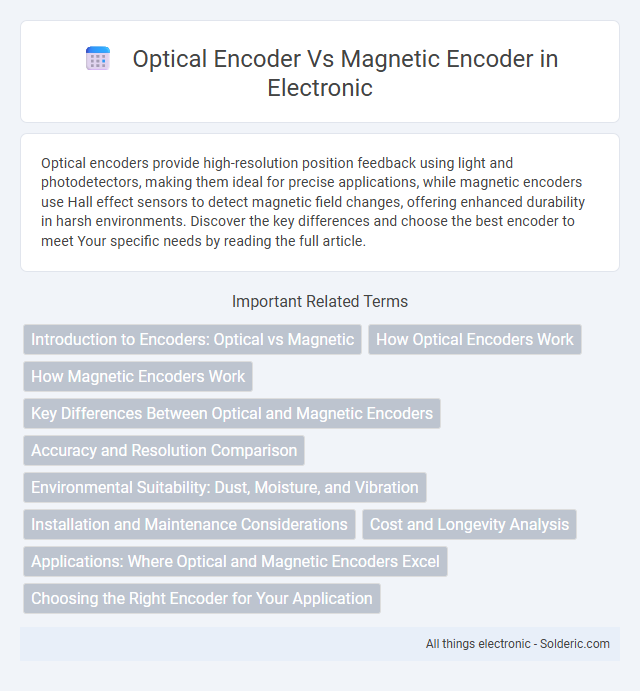Optical encoders provide high-resolution position feedback using light and photodetectors, making them ideal for precise applications, while magnetic encoders use Hall effect sensors to detect magnetic field changes, offering enhanced durability in harsh environments. Discover the key differences and choose the best encoder to meet Your specific needs by reading the full article.
Comparison Table
| Feature | Optical Encoder | Magnetic Encoder |
|---|---|---|
| Working Principle | Measures position using light and photodetectors detecting a patterned disk | Uses magnetic field sensors to detect position from a magnetized scale or ring |
| Accuracy | High precision, typically micrometer-level resolution | Moderate precision, generally lower resolution than optical |
| Environment Resistance | Sensitive to dust, dirt, oil, and moisture | Highly resistant to harsh environments, dirt, oil, and moisture |
| Durability | Less durable due to fragile optical components | More robust with no sensitive optical parts |
| Cost | Generally lower cost for high precision | Typically higher cost due to rugged design and sensors |
| Application Examples | Robotics, CNC machines, precision instruments | Automotive, industrial motors, harsh environmental conditions |
| Signal Output | High-quality, clean digital signals | Signal quality can be affected by magnetic interference |
Introduction to Encoders: Optical vs Magnetic
Optical encoders use light signals to detect position through a rotating disk with transparent and opaque segments, offering high resolution and accuracy in precise motion control applications. Magnetic encoders rely on magnetic fields and sensors to determine position, providing robust performance in harsh environments with dust, vibration, and moisture. Your choice between optical and magnetic encoders depends on the specific environmental conditions and precision requirements of your application.
How Optical Encoders Work
Optical encoders operate by using a light source, typically an LED, shining through a patterned disk attached to a rotating shaft. A photodetector on the opposite side reads interruptions in the light caused by the transparent and opaque segments on the disk, converting these light pulses into electrical signals representing position or speed. This precise light detection method allows optical encoders to offer high resolution and accuracy in motion control applications.
How Magnetic Encoders Work
Magnetic encoders operate by detecting changes in magnetic fields using sensors such as Hall effect or magnetoresistive elements, which convert rotational or linear motion into electrical signals. These encoders offer robust performance in harsh environments, resisting dust, dirt, and moisture better than optical encoders. Your choice of a magnetic encoder ensures reliable position or speed feedback where optical sensors might fail due to contamination or alignment issues.
Key Differences Between Optical and Magnetic Encoders
Optical encoders use light-based sensors to detect position and movement, providing high resolution and accuracy but are sensitive to dust and contaminants. Magnetic encoders rely on magnetic fields generated by magnets and Hall effect sensors, offering robust performance in harsh environments with moderate resolution. Optical encoders excel in precision applications, while magnetic encoders are preferred for durability and reliability in industrial settings.
Accuracy and Resolution Comparison
Optical encoders typically offer higher accuracy and resolution due to their use of finely etched grids and precise light detection, enabling position measurements with sub-micron precision. Magnetic encoders, while generally less accurate, provide robust performance in harsh environments and can achieve resolutions suitable for many industrial applications, often in the range of hundreds to thousands of pulses per revolution. The choice between optical and magnetic encoders depends on the application's required precision versus environmental durability, with optical encoders excelling in high-resolution tasks and magnetic encoders favored for reliability under extreme conditions.
Environmental Suitability: Dust, Moisture, and Vibration
Optical encoders are highly sensitive to dust and moisture, which can obstruct the light path and degrade performance, making them less suitable for harsh or dirty environments. Magnetic encoders use magnetic fields less affected by contaminants and can operate reliably in dusty, moist, and high-vibration conditions. Applications requiring robust environmental tolerance often prefer magnetic encoders due to their resilience against particulate interference and mechanical stress.
Installation and Maintenance Considerations
Optical encoders require precise alignment during installation due to their reliance on light interruption patterns, making them sensitive to dust and contaminants, which necessitates regular cleaning for optimal performance. Magnetic encoders offer easier installation with less stringent alignment requirements and are more resistant to dirt, vibration, and harsh environments, reducing maintenance demands. Selecting between the two depends on the application's environmental conditions and maintenance capabilities.
Cost and Longevity Analysis
Optical encoders generally offer higher precision but come at a higher initial cost and are more susceptible to dust and wear, potentially reducing their lifespan in harsh environments. Magnetic encoders provide a more cost-effective solution with robust performance and longer durability, especially in dirty or moist conditions, due to their non-contact sensing technology. Choosing the right encoder depends on your budget constraints and the environmental demands of your application to ensure optimal longevity and value.
Applications: Where Optical and Magnetic Encoders Excel
Optical encoders excel in high-precision applications such as CNC machines, robotics, and industrial automation where accurate position feedback is critical. Magnetic encoders perform exceptionally well in harsh environments like automotive systems, heavy machinery, and outdoor equipment due to their resistance to dust, dirt, and moisture. Both encoder types serve key roles in motion control, with optical encoders prioritized for precision and magnetic encoders favored for durability and reliability.
Choosing the Right Encoder for Your Application
Optical encoders offer high resolution and precision, making them ideal for applications requiring exact position feedback, such as robotics and CNC machines. Magnetic encoders provide robustness against dust, dirt, and moisture, suitable for harsh environments and industrial automation. Selecting the right encoder depends on factors like environmental conditions, required accuracy, and cost constraints to ensure optimal performance and reliability.
optical encoder vs magnetic encoder Infographic

 solderic.com
solderic.com